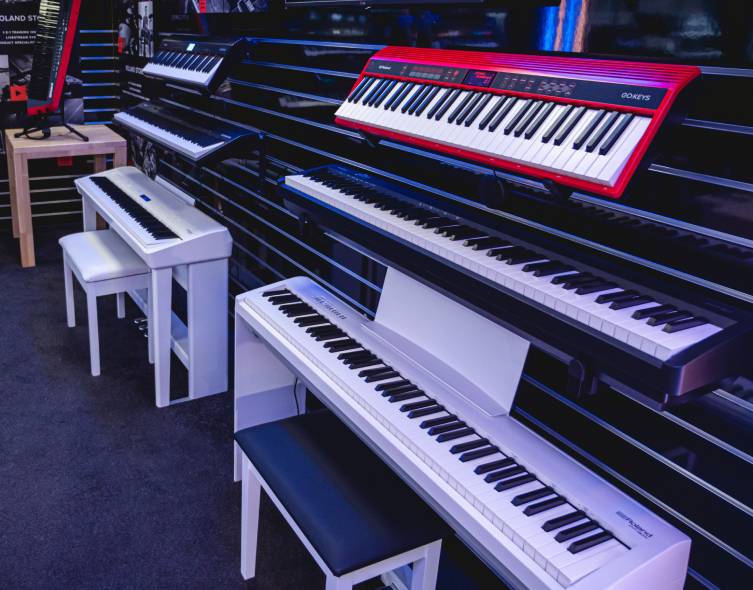
A Beginner’s Guide to Choosing the Right Piano Keyboards
Whether you’ve just decided to learn to play the piano or you’ve been practising for some time now, congratulations on picking a skill involving one of the most beautiful instruments! Having the instrument to practice at home is a great learning advantage, as you can use every minute of spare time to get better.
While most piano players have neither the budget nor the space to afford a grand or an upright acoustic piano, the thing is that such an investment isn’t the greatest idea for beginners. Imagine putting a massive grand piano in the middle of your living room only to decide in a few months that it’s not the right instrument for you and drop learning. The good news is that digital music keyboards have come a long way since they were invented. Available in various types, sizes and features, they allow piano players and music producers of all levels to find a suitable option for their creative process.
The Different Types of Music Keyboards

Digital keyboards are different from acoustic pianos in how they function and produce sound. There are music keyboards online for everyone, whether you want a digital piano that mimics the feel and sound of its acoustic counterpart or keys to help you play and create music. When searching for responsive music keyboards to practice on, you’ll come upon different types such as digital pianos, workstations, arrangers, synthesisers and MIDI controllers. We give you a quick glimpse into each category with its pros and cons to help you make the right decision.
Digital Piano
A digital piano is the closest alternative to the traditional piano, imitating its sounds and feel. It’s the best option for adults who want to learn piano and students who like to focus on practising and musicianship, as it produces an excellent sound and offers volume control. Compared to other keyboards, digital pianos usually have built-in speakers and 88 full-size keys, weighted and graded to mimic those of a genuine piano, making it feel like playing on one.
While it’s ideal for practice and solo performances, it’s less portable than synthesisers and has fewer sound options.
Synthesiser
A synthesiser is an electronic keyboard that can generate a wide sound range, from sound effects to musical instruments. It provides outputs to amps or recording equipment and bridges the gap between a piano and digital keyboards. Because synths are smaller and more portable than digital pianos, they’re excellent for students interested in playing in bands or small ensembles.
You must be careful if you decide on this option, as there’s a wide range of quality between brands. The unweighted keys are another disadvantage and can make the transition to the piano more challenging. And, you can eventually outgrow the keyboard capabilities as you advance in time.
Arranger Keyboard
The goal of arranger keyboards is to provide auto-accompaniment: you can choose several options and let it lay down a backing track matching the rhythm, style and tempo of the piece you play. It helps students play with other musicians while offering them to play solo compositions. Arranger keyboards conform to professional industry standards and are well-suited for composition.
The higher starting prices than those of less advanced keyboards are a common disadvantage. Additionally, beginner players often find the range of programmable options overwhelming.
Workstation Keyboards
A workstation, including a computer for composition and advanced program options, is one of the most expensive music keyboard options. They’re an excellent choice for advanced piano players because they often have weighted keys and for fledging composers because they provide a controller and a laptop for a lower price. However, they’re pricier than other piano keyboards and a bit overwhelming for beginners.
MIDI Controllers
Controllers are usually cheaper than other keyboards since they don’t have built-in sound generators. Instead, they transmit MIDI data to other hardware and software, making them suitable for students interested in creating computer-based music and finding their signature sound. However, controllers are an inadequate choice for those who want to play their music, not program it.
How Do I Choose a Piano Keyboard?

Now that you know the different types of electronic keyboards, you may have a better idea of what option would be the best for your music journey. Here are a few extra factors to consider if you’re still unsure about.
Keyboard Size
The ideal keyboard for adult piano learning may be one with full-size, weighted piano keys. However, these keyboards typically feature fewer sound possibilities. Smaller, unweighted keys with more sound features make an ideal starter keyboard for students interested in electronic music.
Action
Action refers to the responsiveness of a keyboard or piano’s keys when pushed down. The firmness and resistance of the action on each keyboard model differ. Weighted keys respond like a regular piano, making a keyboard with weighted keys suitable for beginners. Unweighted keys are easy to push down.
Computer Connectivity
Computer connectivity is a feature of many of the top keyboard brands. Computer connectivity is a useful alternative for students who intend to use music composition programmes to make their music, even when learning to play is not required. Investing in an entry-level keyboard with computer connectivity today could help you avoid replacing it later.
MIDI Compatibility
“Musical instrument digital interface,” or MIDI for short, is a standard language for electronic instruments that enables them to “speak” to one another by exchanging signals. Although it’s not a must-have for beginners, MIDI compatibility can mean more to the learner if they start listening to electronic music or connect the keyboard to a computer.
Recording Options
Just as MIDI compatibility and computer connectivity are significant considerations, students who wish to compose music should consider sampler and recording choices. When you compose your music, having the ability to record MIDI output is necessary. Some models have an integrated sampler, and top models come with additional features like touch pads, knobs, and faders.


